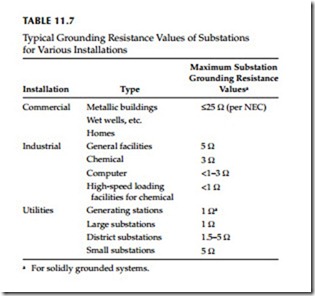Ground Resistance Values
The NEC code states that the resistance to ground shall not exceed 25 Ω.
This is the maximum value of ground resistance and in most applications a much lower ground resistance is required.
“How low a ground resistance should be?” An arbitrary answer to this question is difficult. The lower the ground resistance, the safer, and for positive protection of personnel and equipment, it is worth the effort to aim for less than 1 Ω. It is generally impractical to reach such a low resistance along a distribution system or a transmission line or in small substations.
In some regions, resistances of 5 Ω or less may be obtained without much trouble. In others, it may be difficult to bring resistance of driven grounds below 100 Ω.
Accepted industry standards stipulate that transmission substations should be designed not to exceed 1Ω resistance. In distribution substations, the maximum recommended resistance is for 5 Ω or even 1Ω. In most cases, the buried grid system of any substation will provide the desired resistance.
In light industrial or in telecommunication central offices, 5 Ω is often the accepted value. For lighting protection, the arrestors should be coupled with a maximum ground resistance of 1 Ω. Table 11.7 shows typical values of ground resistance for various types of installations.
Grounding nomograph
These parameters can usually be met with the proper application of basic grounding theory. There will always exist circumstances which will make it difficult to obtain the ground resistance required by the NEC or other safety standards. When these situations develop, several methods of lowering the ground resistance can be employed. These include parallel rod systems, deep-driven rod systems utilizing sectional rods and chemical treatment of the soil. Additional methods, discussed in other published data, are buried
plates, buried conductors (counterpoise), electrically connected building steel, and electrically connected concrete reinforced steel.
Electrically connecting to existing water and gas distribution systems was often considered to yield low ground resistance; however, recent design changes utilizing nonmetallic pipes and insulating joints have made this method of obtaining a low-resistance ground questionable and in many instances unacceptable.
